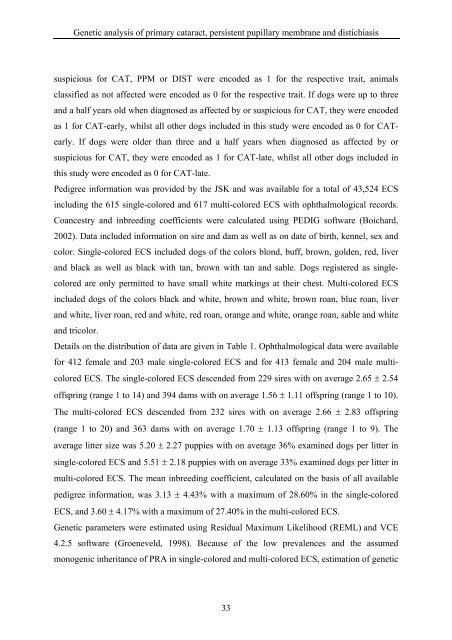Aus dem Institut für Tierzucht und Vererbungsforschung - Stiftung ...
Aus dem Institut für Tierzucht und Vererbungsforschung - Stiftung ...
Aus dem Institut für Tierzucht und Vererbungsforschung - Stiftung ...
You also want an ePaper? Increase the reach of your titles
YUMPU automatically turns print PDFs into web optimized ePapers that Google loves.
Genetic analysis of primary cataract, persistent pupillary membrane and distichiasis<br />
suspicious for CAT, PPM or DIST were encoded as 1 for the respective trait, animals<br />
classified as not affected were encoded as 0 for the respective trait. If dogs were up to three<br />
and a half years old when diagnosed as affected by or suspicious for CAT, they were encoded<br />
as 1 for CAT-early, whilst all other dogs included in this study were encoded as 0 for CAT-<br />
early. If dogs were older than three and a half years when diagnosed as affected by or<br />
suspicious for CAT, they were encoded as 1 for CAT-late, whilst all other dogs included in<br />
this study were encoded as 0 for CAT-late.<br />
Pedigree information was provided by the JSK and was available for a total of 43,524 ECS<br />
including the 615 single-colored and 617 multi-colored ECS with ophthalmological records.<br />
Coancestry and inbreeding coefficients were calculated using PEDIG software (Boichard,<br />
2002). Data included information on sire and dam as well as on date of birth, kennel, sex and<br />
color. Single-colored ECS included dogs of the colors blond, buff, brown, golden, red, liver<br />
and black as well as black with tan, brown with tan and sable. Dogs registered as singlecolored<br />
are only permitted to have small white markings at their chest. Multi-colored ECS<br />
included dogs of the colors black and white, brown and white, brown roan, blue roan, liver<br />
and white, liver roan, red and white, red roan, orange and white, orange roan, sable and white<br />
and tricolor.<br />
Details on the distribution of data are given in Table 1. Ophthalmological data were available<br />
for 412 female and 203 male single-colored ECS and for 413 female and 204 male multicolored<br />
ECS. The single-colored ECS descended from 229 sires with on average 2.65 ± 2.54<br />
offspring (range 1 to 14) and 394 dams with on average 1.56 ± 1.11 offspring (range 1 to 10).<br />
The multi-colored ECS descended from 232 sires with on average 2.66 ± 2.83 offspring<br />
(range 1 to 20) and 363 dams with on average 1.70 ± 1.13 offspring (range 1 to 9). The<br />
average litter size was 5.20 ± 2.27 puppies with on average 36% examined dogs per litter in<br />
single-colored ECS and 5.51 ± 2.18 puppies with on average 33% examined dogs per litter in<br />
multi-colored ECS. The mean inbreeding coefficient, calculated on the basis of all available<br />
pedigree information, was 3.13 ± 4.43% with a maximum of 28.60% in the single-colored<br />
ECS, and 3.60 ± 4.17% with a maximum of 27.40% in the multi-colored ECS.<br />
Genetic parameters were estimated using Residual Maximum Likelihood (REML) and VCE<br />
4.2.5 software (Groeneveld, 1998). Because of the low prevalences and the assumed<br />
monogenic inheritance of PRA in single-colored and multi-colored ECS, estimation of genetic<br />
33










![Tmnsudation.] - TiHo Bibliothek elib](https://img.yumpu.com/23369022/1/174x260/tmnsudation-tiho-bibliothek-elib.jpg?quality=85)






